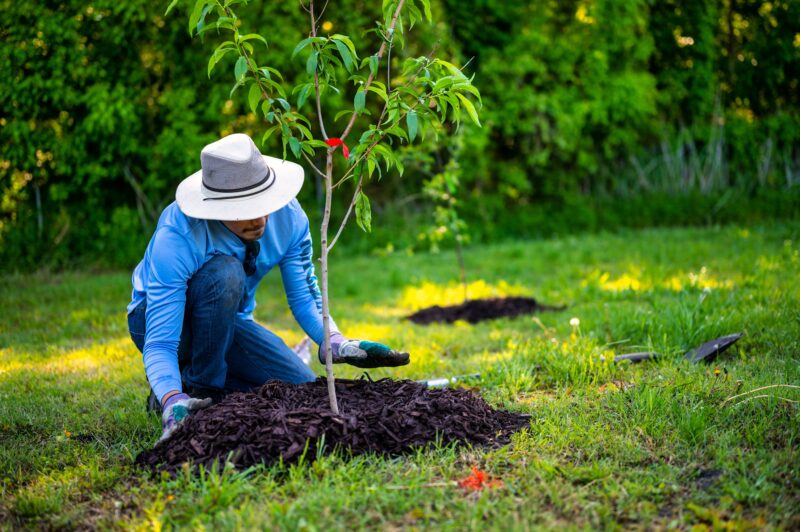Planting and care of trees
Trees provide us with many gifts: shade, wind breaks, erosion control, beautiful foliage, an invitation to birds and other wildlife and, in the case of fruit or nut trees, something tasty to harvest.
Like other perennial plants, when selecting a tree, first consider the location. The amount of sunlight the tree will receive, soil type, soil pH, water availability and retention are all important factors that will affect your tree’s healthy growth.
Don’t forget to consider the mature size of the tree, including its anticipated height as well as how wide its branches and roots will spread. Awareness of these factors can minimize the need for drastic pruning or the eventual removal of the tree because it’s grown too close to a structure or overhead wires.
For help in choosing the right tree, see the Vermont Community and Urban Forestry Program’s tree selection tool at go.uvm.edu/tree-selection.

After planting, cover the soil around the tree with a layer of mulch a few inches thick to help retain moisture and prevent growth of weeds. Pull the mulch a few inches away from the trunk to avoid creating a “mulch volcano,” which can lead to disease, rot and other problems.
The best time to plant a tree is while it’s dormant and the ground is workable in early spring or late fall. If you order trees to be shipped to you, they’re usually sent at an appropriate time for planting. Bare-root trees will include instructions for rehydrating the roots before planting.
You can purchase your tree at a local nursery (usually with roots and soil in a container of some type) or by mail order (often shipped dormant and bare-root). Either way, plan to plant as soon as possible after its arrival.
If you purchase locally, the tree will likely be in a large pot or with its roots bundled in burlap. While timing for planting trees growing in a container is more flexible, avoid excessively hot and dry conditions or other extremes that will further stress the young tree.
When you’re ready to plant, dig a hole about three times wider than the root ball. Dig as deep as the height of the root ball, plus deep enough to allow the top of the root flare to be above the soil once planted. The root flare is where the trunk widens out at the base of the tree.
Remove the container or any burlap, wire or other material used to contain the roots. If roots have grown to encircle the container, gently free them or trim so future growth will be outward from the tree. Carefully move the tree into the hole, spreading the roots. Be sure it’s positioned to stand straight up.
Refill the hole with the original soil, breaking up any clumps. Tamp in place. Water to help the soil settle and collapse any air pockets. Add more soil as needed. Finally, water well. Any branches that have been damaged can be pruned.
Installing an expandable trunk wrap at the time of planting, or any time before the onset of winter, can help deter nibbles by hungry wildlife that can injure or girdle the young tree. If in a windy area or if you’ve planted a bare-root tree with a small root system, staking the tree may be necessary for the first year.
Finally, cover the soil with a layer of mulch a few inches thick to help retain moisture and prevent growth of weeds. Be sure to keep mulch a couple of inches away from the trunk. Above all, don’t pile mulch around the tree into a “mulch volcano,” which can lead to disease, rot and other problems.
Keep your tree evenly watered. Avoid allowing the soil to dry out, especially during excessive summer heat. In general, plan on watering deeply at least once a week during the growing season.
For more detailed information on planting and caring for trees, see vtcommunityforestry.org/tree-care.
(Deborah J. Benoit is a University of Vermont Extension master gardener from North Adams, Mass., who is part of the Bennington County Chapter.)

